Project reduced energy use
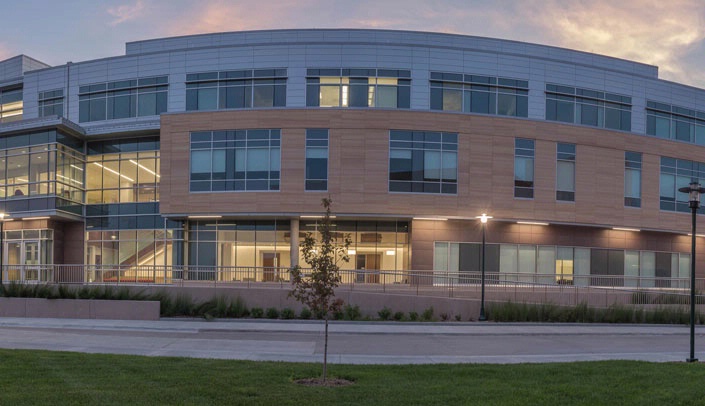
Reducing energy use is an important part of the medical center’s effort to achieve net zero building emissions by 2030.
In February of 2020, a local energy management firm partnered with the department of facilities, management and planning to optimize the Lauritzen Outpatient Center with this goal in mind. The six-month project helped make the building more efficient and correct pressure issues, which were most noticeable in the walkway between the Lauritzen Outpatient Center and the UNMC Center for Drug Discovery. More lighting controls also were installed, all of which helped the med center reduce emissions.
In buildings that have operating rooms and labs, there are different air requirements to keep everyone safe. More air is exhausted outside and is replaced with fresh, conditioned air. Replacing the air faster in these spaces not only uses more energy but sometimes can create pressure issues. Because almost all buildings on campus are connected, you can often feel a “breeze” in smaller spaces, like hallways and walkways.
The energy optimization project examined the programming of all HVAC systems to ensure proper functionality and appropriate conditioning of spaces. Occupants should be comfortable during the day, but systems can be slowed during unoccupied times in order to save energy. Alongside the optimization project, new lighting sensors were installed to adjust lighting levels based on number of occupants in a space.
With the changes from this project, the med center reduced energy use by 3.7 million KBtus and saved more than $103,000 in just the first year. The facilities department expects energy savings to continue and cost avoidance to increase as well. The emissions impact from this reduction in energy use is equivalent to removing 167 passenger vehicles from the road for one year.
Reducing emissions from energy use contributes to the med center’s mission to create a healthy future for all. Emissions cause a variety of health impacts, including cancer, asthma, respiratory allergies, foodborne disease, mental health disorders and more.
Facilities will continue to work on optimizing buildings on campus, and there are many ways you can help. Discover steps you can take during the work day or ways to implement energy saving strategies at home.
International Plastic Bag Free Day is July 3
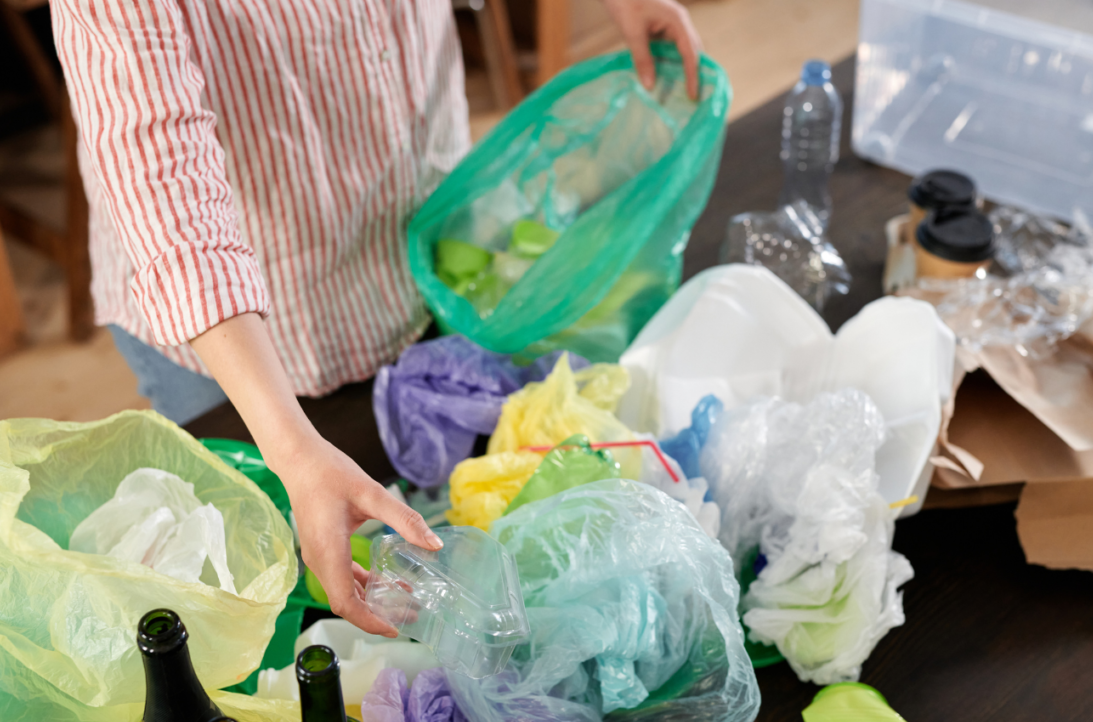
Did you know that 5 trillion plastic bags are produced annually? If they were put end to end, those plastic bags would wrap around the entire planet seven times!
This Saturday, July 3, is International Plastic Bag Free Day, an initiative that aims to eliminate plastic bags as part of an effort toward a cleaner planet. Plastic has become a very prevalent topic in the past few years because it is a huge problem when it comes to pollution and the health and well-being of the Earth, and especially our oceans.
As of February 2021, only eight states and a few cities in the U.S. have banned plastic bags in supermarkets and businesses. Other states have begun using different types of compostable/ biodegradable bags or have incorporated reward systems for bringing in reusable bags. Even with efforts like these to reduce the use of plastic bags, the bags and other plastic waste are harming the environment at an alarming rate.
Any plastic bag ever used is still degrading and will likely continue to degrade for 1,000 years or longer. After that, it breaks down into microplastics and fibers, which absorb toxins and can get washed into the ocean, where sea animals often mistake them for food. Recent studies show large amounts of microplastics and fibers in sea animals’ guts, which directly correlate to human health if humans consume any type of seafood. There still are some uncertainties around the negative effects of humans ingesting plastic, but some might include: cancer, cardiovascular disease, diabetes, chronic inflammation and stroke.
Any type of plastic, whether it’s plastic bags or plastic water bottles, is detrimental to the environment and ecosystems. If plastic doesn’t get washed into the ocean, it can get into other water systems or into soil which also circles back into our supply of drinking water and our food.
Overall, plastic use is still increasing. To learn more about the effects of plastic and what you can do, check out the following resources:
- An informational Prezi presentation highlighting the most common plastics used at home and how to eliminate them.
- Plastic-Free webinar with the med center’s own Brian Jefferies, who has almost completely eliminated plastic in his household.
- The med center’s Plastic Free Ecochallenge team — From July 1-31, you can pledge to take specific actions to reduce plastic in your life.
Recycling event a success
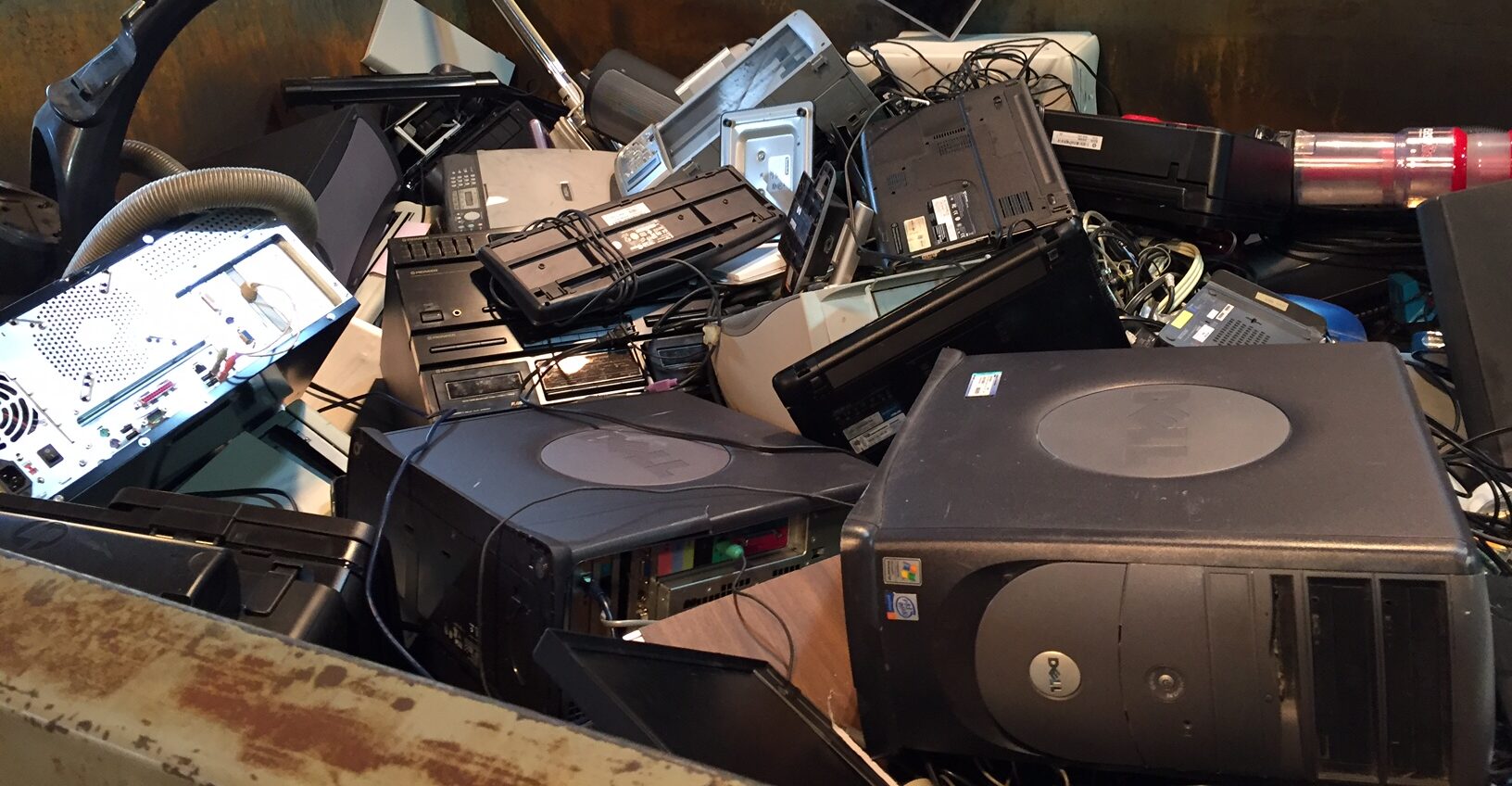
This year, the medical center was fortunate to have its annual recycling event during Earth Month as usual, in partnership with the University of Nebraska at Omaha.
Over the course of the two-day event in April, materials received included:
- 471 lbs. of assorted media (VHS tapes, DVDs, CDs and floppy disks);
- 7,466 lbs. of electronic waste;
- 3,910 lbs. of paper for shredding;
- 190 lbs. of alkaline batteries (approximately 2,500 batteries); and
- 3.5 lbs. of rechargeable/button batteries
That’s 12,040 total pounds diverted from the landfill. That impact equates to approximately:
- 31 trees saved
- 163 gallons of oil not used
- 367,212 hours of electricity saved
- 4,971 gallons of water conserved
Also donated:
- $800 and a carload of food to the Maverick Food Pantry;
- A blue recycling bin full of eyeglasses to the Truhlsen Eye Clinic; and
- Three boxes of pop tabs to Ronald McDonald House.
Event organizers offered a “thank you” to volunteers Mithla Albulushi, Marion Entz-Harris, Helga Fensterman, Sarah Fleenor, Elizabeth Hill, Sushma Kolumban, Jessica Macossay, SarahMcLain, Leracha Simon, Lacy Snyder and Jennifer Wemhoff.
This year’s collected waste was about half the amount collected last year, when nearly 29,000 lbs. of material for recycling was collected. That’s not bad news, though — during the first few months of the pandemic, lots of people cleaned out their houses, which meant they were looking for ways to responsibly dispose of materials in 2020. This year, plenty of materials still were diverted from the landfill.
Alongside proper disposal of items like the ones collected in April, there is more that everyone can do to reduce waste with regard to paper and technology. To reduce environmental impact and save money, do some research before buying products to see how long the product will last. Consider spending more for something that will last longer.
Other ways to reduce waste include printing less, unsubscribing from mailing lists and upgrading to rechargeable batteries. Reducing waste is a crucial first step, while recycling is an important last step, for ensuring waste is disposed of responsibly.
Sustainability win with reusable isolation gowns

While essential, personal protective equipment (PPE) produces a large volume of waste.
Nebraska Medicine has created a practical way to reuse their isolation gowns that reduces this waste. In 2000 when Nebraska Medicine’s laundry facility closed, Nebraska Medicine partnered with Ameritex Laundry Services (a Healthcare Accredited Laundromat) and sent their isolation gowns and other linens to be washed and then reused.
After the gowns are used at the medical center, they are transported to Ameritex laundry. Once they are diligently washed, gowns are stored at a warehouse until they are ordered back to the medical center. On top of the usual cleaning, gowns also are put through an impermeability treatment once a month. As long as the gowns do not endure any tears, they can be reused more than 100 times. When the gowns do get torn, Ameritex Services rags out the linens for reuse. The ragged-out linens are then dropped off to Peerless Wiping Cloths. This company repurposes the linens into wiping cloths and Nebraska Medicine receives a small payment of $0.05 per pound for these recycled linens.
Even with the cost of replacing isolation gowns that are damaged or going missing, the process saves Nebraska Medicine money. Not only can linen gowns be reused over 100 times, but the system does not need to pay for the collection and transportation to a landfill or a landfill fee.
Because Nebraska Medicine is reusing gowns, around 2,000 disposable gowns don’t have to be purchased on a daily basis. During the height of the pandemic, with increased PPE needs, around 10,000 disposable gowns a day didn’t have to be purchased, although due to an increased demand, some new linen gowns were procured. The pandemic created a large demand for isolation gowns with a limited supply, so disposable gowns were as much as 10 times as expensive at times, while linen gowns remained the same price. Being able to reuse many gowns quickly not only saved the system money, but freed up disposable gowns for other health systems to purchase.
Reusing gowns diverts tons of waste from landfills and uses much less energy than what is required to harvest raw materials, manufacture and ship disposable gowns. Not only is this process beneficial for the environment, it creates a structure resilient to disturbances like the COVID-19 pandemic.
Med center in energy curtailment
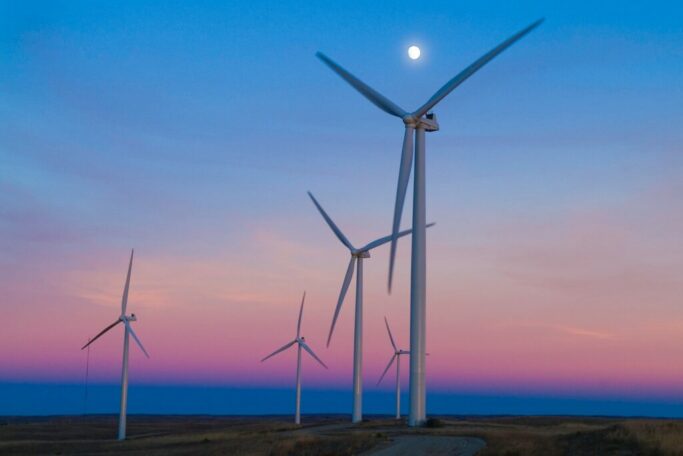
UNMC and the Nebraska Medical Center will be in energy curtailment through Friday. The goal of energy curtailment periods is to use less energy on days when the combined heat and humidity create stress on campus energy systems.
The Energy Curtailment page of LiveGreen provides a full explanation, but you should no longer be freezing cold in your office during energy curtailment. Please note that when you first walk in it will still feel cool.
In the past, many of you felt cold on curtailment days. It seemed backward, that you would save energy by having it be colder in spaces when it was so hot out. It was an effective way to save energy and money though — it’s inefficient to produce heat when it’s hot out, and that’s what we were doing. By not producing that heat, some spaces felt cold.
Due to updated technology, spaces will not need to be pre-cooled to as cold of temperatures as in the past in order to see the energy savings. This does mean that your space will likely get warmer in the afternoon. For example, instead of finding your space at 67 degrees when you arrive, it could be at 70. In the afternoon, instead of being at 72, it will be 75.
Not only does this tend to mirror what happens in a residential situation, but it is also overwhelmingly what you, the building occupants, have requested. You were cold sitting at your desk and would rather have it be a little warmer and we are happy to report that this is now possible.
The med center has a temperature range to maintain. Please call 402-552-3347 (Nebraska Medicine) or 402-559-4050 (UNMC) to report spaces colder than 66 degrees or warmer than 78 degrees.
Patient care and research spaces are not affected by energy curtailment. Read how you can help save energy during curtailment and always.
World Oceans Day

Today is World Oceans Day — a day essentially as important as Earth Day, considering how much the ocean supports humanity and all other organisms on earth.
Oceanic and human life are both at great risk as the climate continues to change. Oceans cover 70% of the earth, absorb 93% of the heat from the sun and capture 30% of the carbon dioxide from the atmosphere. Forty percent of the world’s population lives within 60 miles of the coast, and half a billion people rely on the ocean for their primary food intake. Taking all these statistics into account, it’s easy to see how human survival is directly correlated with oceanic survival.
We already have seen drastic changes in oceans’ water levels, pH and currents, all of which are huge components in sea life and human survival.
- As water levels continue to rise, there will be more deadly storm surges and flooding. This has specific impacts on coastal states, but landlocked states also will be impacted when it comes to seafood consumption, agriculture production, population control issues and more.
- The ocean’s pH already has changed from about 8.2 to now 8.1. This doesn’t seem like a huge decrease, but because it’s measured logarithmically, it is an enormous change. The ocean is nearly 25% more acidic now than it was before the Industrial Revolution. With this increase in acidity, some species are not able to survive, which throws off the entire ecosystem.
- Ocean currents are starting to change in direction and size. This makes water from different regions mix together, affecting the temperature of the ocean and ultimately having significant impact on the weather.
The overwhelming amount of changes already occurring causes concern, but luckily there are many groups helping to bring attention to the issues in our oceans. Visit the World Oceans Day website to find resources on where to learn more. Also, check out Dr. Ayana Elizabeth Johnson’s interview with Ezra Klein to learn more about the role of oceans in our lives and in the fight against climate change.
By helping protect the ocean, we also are helping protect the human population and our health.
World Environment Day is June 5

This Saturday, June 5, is World Environment Day. This day was founded in 1972, and in the following years, a platform was created to raise awareness about the many problems facing the environment. Some of these problems include air pollution, plastic pollution, sea level increase and food security.
Every year, a theme is declared that focuses on one major issue. This year, it’s ecosystem restoration. The diversity and wellbeing of our ecosystems correlate with the health and wellbeing of the human population, through benefits such as more fertile soils, bigger yields of timber and fish, the storage of greenhouse gas emissions and more.
Ecosystem restoration ties in with the 17 United Nations Sustainable Goals in a number of ways. Two goals impacted by this year’s theme are “Life Below Water” and “Good Health and Well-Being.”
Restoration to ecosystems below water is important considering water covers 71% of the earth’s surface. Climate change already has significant impacts on oceans, and millions of tons of plastic waste is being dumped into the water — with detrimental effects on all ecosystems. If there are drastic changes to the ecosystems below water, there will be negative effects to human health and wellbeing. For example, seafood will become contaminated as animals consume the waste that’s piling up in the oceans. One slight change in the aquatic ecosystem can have a domino effect on all other ecosystems in the environment. With restoration to ecosystems below water, our oceans, land and air will be cleaner, and human health and wellbeing will flourish.
There are many subcategories of ecosystems that are being focused on this year for World Environment Day, like farmlands, forests, freshwaters, grasslands and savanna’s, mountains, oceans and coasts, peatlands and all urban areas. On the World Environment Day webpage, you can play a game and choose which ecosystem you want to learn more about, get updates on what is happening and pledge to act.
How you decide to commemorate World Environment Day this year — whether it’s educating yourself and others or taking actions to help make our ecosystems healthier — can have a lasting impact on not only the health and wellbeing of our planet but also all of the people living on it.
Energy curtailment

Energy curtailment allows the university to control its maximum energy demand, or “peak.”
By reducing unnecessary energy use, the university can ensure that essential energy needs are met. Lower energy means lower emissions, better air quality and better health for the community – the Med Center’s mission. It also saves the Med Center money, as utility rates are based on peak use. The maximum of energy used at any given time determines the rate the Med Center pays for the entire next year.
Updating technology has allowed the Med Center to control this process better. Spaces that were previously cold will be affected differently by energy curtailment. They will still be pre-cooled at night. “Pre-cooling” is a literal term — spaces are cooled in the early morning before people arrive. This also is when energy use is lower across campus, and before the sun shines and temperatures increase. Spaces are often cooled below the temperature set on the thermostat, which makes it easier for the system to keep up once the heat and humidity are in full effect.
However, these spaces will not need to be pre-cooled this year to such a cold temp to see the energy savings. This does mean that your space will likely get a little warmer in the afternoon. Not only does this tend to mirror what happens in a residential situation, it is overwhelmingly what you, the building occupants, requested.
Research and patient care areas are not impacted by energy curtailment.
We need your help! When we are in energy curtailment, we’ll ask you to help ease the energy load:
- Close shades, blinds and curtains whenever possible to reduce solar heat gain. (Did you know this can decrease the temperature by more than 20 degrees?);
- Lower lighting levels where possible, turn off lights in unoccupied areas and when leaving a room;
- Turn off and unplug all electrical equipment not in use (computers, coffee makers, printers, chargers, etc.);
- Shut fume hood sashes when not in use. (This does not decrease safety; fans are always running, but can slow down with a smaller opening, which is why it is quieter);
- Open doors manually instead of using the ADA buttons;
- Take the stairs instead of the elevator; and
- Tell others.
These easy steps combine to have a huge impact, on the hot days and for the year ahead.
Happy National Transportation Week
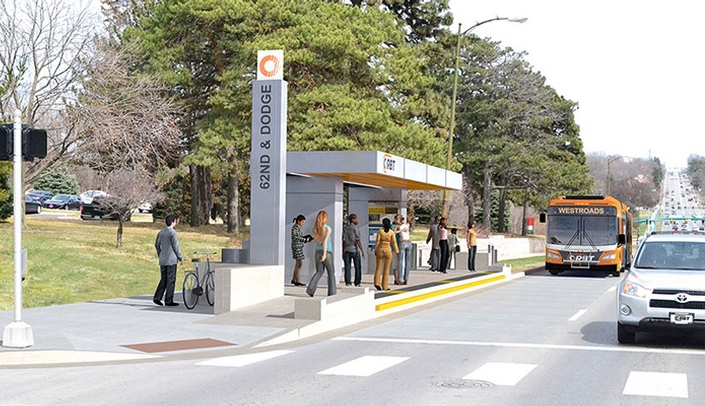
May 17-23 is National Transportation Week — a week designed to acknowledge the hard-working employees in the transportation industry. Especially during this past year, as Omaha Rapid Bus Transit (ORBT) was launched alongside the challenges of the pandemic, Omaha’s transportation employees took on many obstacles.
National Transportation Week also provides an opportunity to recognize the many benefits of public transportation. As more people use public transportation, fewer cars on the road are releasing emissions that pollute the air. Increased use of public transportation also leads to a reduction in the need for parking, which costs money and takes up space.
Plus, it’s healthier for your body. Air pollution has many connections to public health issues, including myocardial ischemia, chest pain, coughing, throat irritation and more. And there is a much lower rate of passenger death rates for buses compared to passenger vehicles.
ORBT helps eliminate many of the barriers that might normally prevent individuals from using public transportation as it is fast, cheap (free until early summer) and convenient. Metro Transit also just announced on April 22 that K-12 students will ride for free as a part of a new pilot program.
If you are unable to use public transportation or are concerned because of the pandemic, another sustainable option is to ride a bicycle. Like using public transit, biking helps the environment and benefits your health in many ways, through increased cardiovascular fitness, decreased stress levels, decreased body fat levels and reduced anxiety and depression. To learn more about the health benefits of bicycling, click here.
You can celebrate National Transportation Week by:
- Attending our Metro Transit webinar with Jason Rose, on May 19 at 11-11:30 a.m., to learn more about ORBT and the future of Omaha Metro Transit. Save this Zoom link to join the webinar next Wednesday.
- Trying out ORBT or another city bus (or riding your bicycle) instead of using your car, even for a short errand. When you do, consider thanking city bus drivers and follow appropriate safety procedures.
- Making a change in your commute to campus. Register here for our TravelSmart program to get started.
Bikeshare and transit
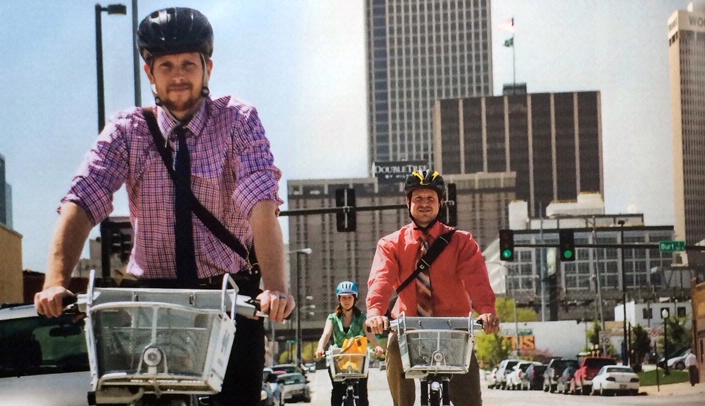
As the weather warms up, we can expect to see an increase in bicycle commuters coming to campus.
If you don’t own a bicycle, or only need a bicycle for part of your commute, Heartland B-Cycle’s program can be an excellent option to provide transportation to campus.
Active commuting can be inconvenient due to limited access to transit stops. By using bikeshare, riders can get closer to a destination where buses might not travel. Bikeshare can be a catalyst for people who want to ditch their car but are held back by the “first and last mile” problem, or who live just far enough that walking isn’t always an option. Using a B-Cycle bike also eliminates concerns about taking your bike on the bus or locking it outside on campus. With the addition of electric bikes to the B-Cycle fleet, riders can choose to have a little help getting up those hills and can arrive to work or school faster (and less sweaty).
Biking also makes you healthier in many ways. A study in the United Kingdom in 2017 found that “commuters who cycled to work had a 41% lower risk of dying from all causes than people who drove to work.” Bike commuters had similarly lower risks of developing and dying from cardiovascular disease and cancer. Biking and using the bus also decrease emissions that pollute the environment and harm our health.
Heartland B-Cycle has stations across the metro area. Check out the station map to find locations that are convenient for your commute — like one of the six stations on or near the Omaha campus. You can also use the station map to see how many bikes are available at each station and if there are any electric bikes, as well. On your ride to work, remember to always wear a helmet, and ride with the traffic or use bicycle lanes whenever possible.
This month, Nebraska Medicine employees can purchase an annual B-Cycle pass for a discounted rate of $20 through the Wellbeing Department. Contact Zac Turbes at 402-552-2775 or visit the Fitness Center on the ground floor of Clarkson Tower. There are a limited number of passes, so passes will be first-come, first-served. UNMC students can receive a discounted pass through B-Cycle’s student program, which offers annual passes at a rate of $50 per pass.
